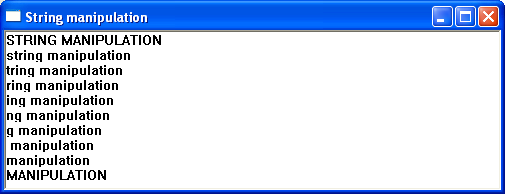The string manipulation functions of the Win32 API allow an application to test and manipulate the contents of a string. A selection of these is listed below. For a full list of string manipulation functions – https://docs.microsoft.com/en-us/windows/win32/menurc/string-functions
CharLower
Translates a character string to lowercase.
LPSTR CharLower(LPSTR lpsz);
Where lpsz is a null-terminated string or specifies a single character. If the operand is a character string, the function returns a pointer to the converted string.
CharNext
Retrieves a pointer to the next character in a string. The prototype for this function is
LPSTR CharNext(LPCSTR lpsz);
Where lpsz is a character in a null-terminated string. The return value is a pointer to the next character in the string, or to the terminating null character if at the end of the string.
CharPrev
Positions pointer to the previous character in a string.
LPSTR CharPrev(LPCSTR lpszStart,LPCSTR lpszCurrent);
where
LpszStart – The beginning of the string.
LpszCurrent – A character in a null-terminated string.
The return value is a pointer to the preceding character in the string, or to the first character in the string
CharUpper
Converts a character string to uppercase. The prototype for this function is
LPSTR CharUpper(LPSTR lpsz);
Where lpsz is a null-terminated string or a single character. If the operand is a character string, the function returns a pointer to the converted string.
IsCharAlpha
Determines whether a character is an alphabetical character.
BOOL IsCharAlpha(CHAR ch);
Where ch is the character to be tested. If the character is alphabetical, the return value is nonzero. If the character is not alphabetical, the return value is zero.
IsCharAlphaNumberic
Determines whether a character is an alphanumeric character.
BOOL IsCharAlpha(CHAR ch);
Where ch is the character to be tested. If the character is alphanumeric, the return value is nonzero. If the character is not alphanumeric, the return value is zero.
IsCharLower
Determines whether a character is lowercase.
BOOL IsCharLower(CHAR ch);
Were ch is the character to be tested. If the character is lowercase, the return value is nonzero. If the character is not lowercase, the return value is zero.
IsCharUpper
Determines whether a character is uppercase.
BOOL IsCharLower(CHAR ch);
Where ch is the character to be tested. If the character is uppercase, the return value is nonzero. If the character is not uppercase, the return value is zero.
Lstrlen
Determines the length of the specified string excluding the terminating null character.
int lstrlen(LPCSTR lpString);
Where lpString is the null-terminated string to be checked.
The function returns the length of the string, in characters.
Example
The following short program demonstrates various API string manipulation functions
